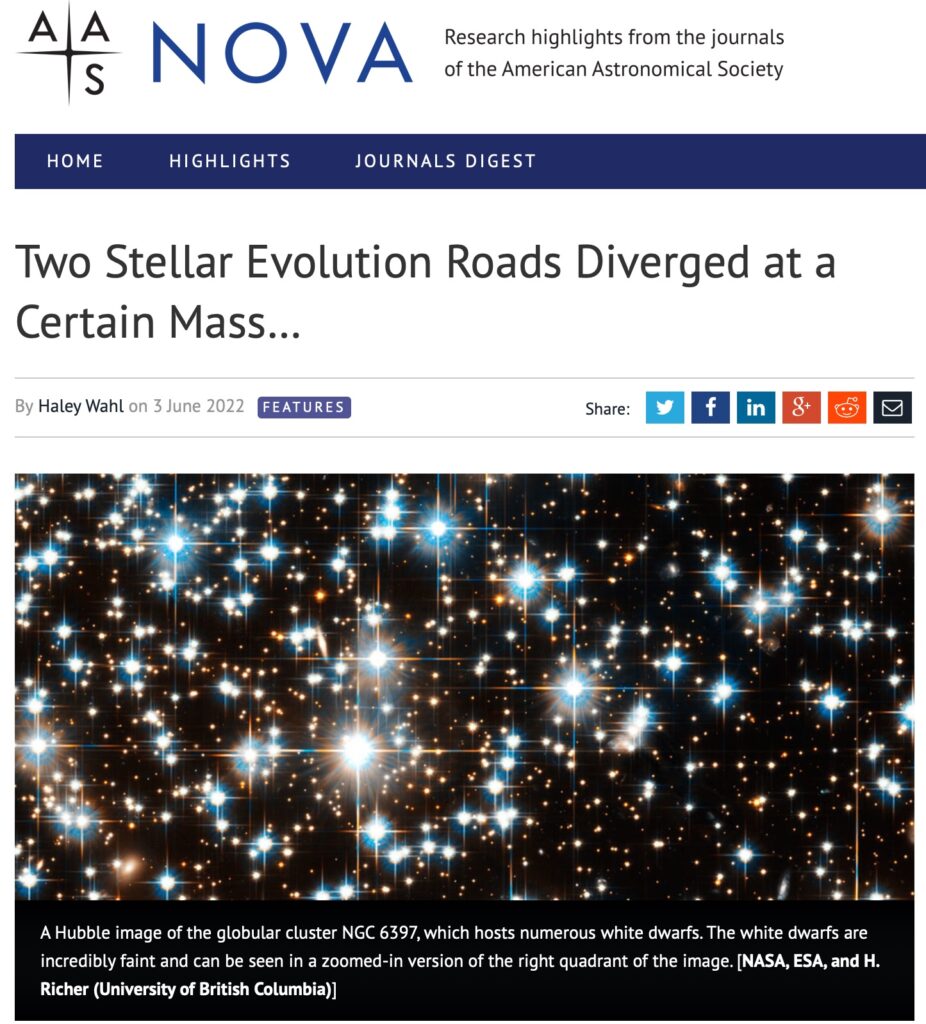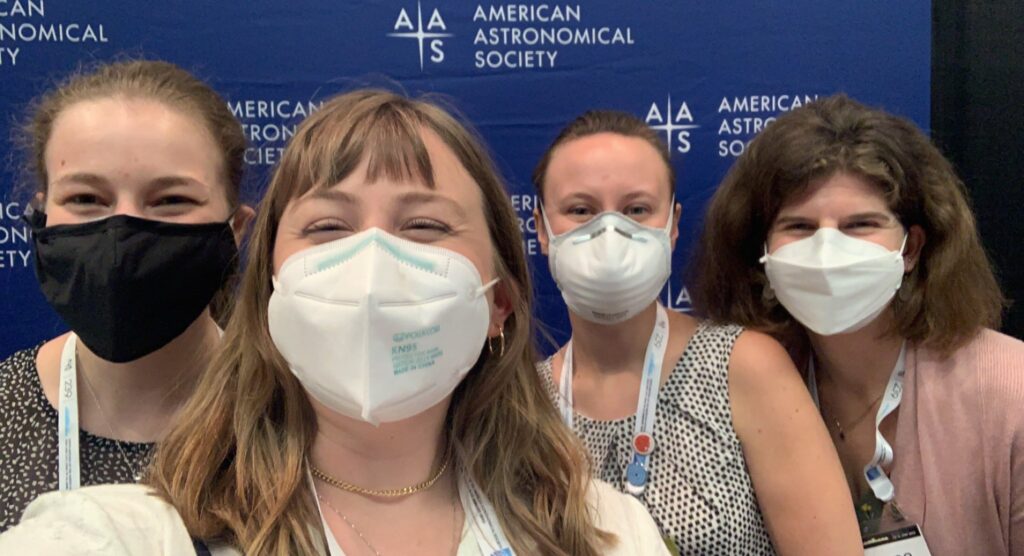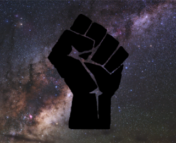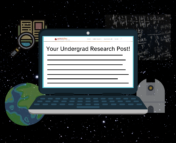After doing astronomy research in undergrad, I was sure that my future career would involve exploring the mysteries of the universe. As I progressed through graduate school, however, that end goal seemed to shift, and I realized my new dream was to teach people about the universe through science communication rather than exploring it myself.
I’ve always loved the night sky and got my start in observational astronomy (aka stargazing in my backyard), so when I was offered the chance to work at the WVU planetarium as a part of a teaching assistantship, I jumped at the opportunity. I spent 2 years creating short presentations about Messier objects, giving tours of the night sky to elementary schoolers, and introducing the people of Morgantown to the wonders of the universe that have captivated me for years. While working at the planetarium, I also joined the staff at Astrobites. Applying for Astrobites was a last-minute decision I made on a whim, but looking back, it was the single best decision I made in grad school. The opportunity allowed me to combine my love of writing, which I’ve had since I was little, with my science training, and bring the science that was often obscured by equations and dense graphs down to a level that the general public could understand. Astrobites is sponsored by AAS, so I was able to cover a few meetings (which meant live-tweeting and blogging sessions) and that was a really great experience. After I finished my 2-year term writing for Astrobites, I branched out and started communicating science through other avenues (see the Pulsars and Profiteroles Project and #PulsarFriday). When the chance to work for AAS as a media fellow and continue science writing while also learning about the world of the press and academic publishing came up, I was so excited to apply!

Preparing Your Application
The AAS Media Fellowship was developed in 2017 to provide training and experience for a graduate student in the astronomical sciences interested in science communication. It’s a paid fellowship and works out to ~8 hours of work per week. Applications are open now and close July 6, 2022.
There are three rounds to the AAS Media Fellowship application process. The first is sending in your resume and cover letter. To prepare these, I went to my university’s Career Center and they helped me refine my resume and tailor my cover letter to highlight why my strengths and experiences made me a good fit for the position. In addition, the application requires you to have your advisor send an email to AAS saying they’re okay with you applying, because the fellowship is a work commitment that comes in addition to your graduate studies. My advisor is very supportive of my science communication path, so she was more than happy to send the email. If you get through to the second round, you’ll be asked to write two posts in the style of AAS Nova. One post will be about a paper that is chosen for you, and the other will require you to choose a paper from a short list of papers from the AAS journals. The former will challenge you to write about a paper that may be outside your research area, and the latter will test your ability to find newsworthy articles. I used my experience writing for Astrobites and summarizing papers to help me write the application articles, but the style for AAS Nova is slightly different so make sure you take a peek at those first. The last round is an interview, which will help the selection committee determine if you’re right for the role.
The process takes a while, but I learned so much from it. I just finished the process of applying for jobs in science writing/science communication and can say that the process is very similar to applying for the AAS Media Fellowship. Even if you go through the application process and are ultimately not are not selected, applying is a huge learning experience and is very good practice for the job market.
What I Learned from the Fellowship Experience
The fellowship has three main components: managing press releases, writing Nova articles, and assisting with AAS meetings. Press releases from universities, observatories, government agencies, etc. are posted on the AAS Press Twitter account and Astronomy in the News. Usually the press team takes shifts throughout the week and during your shifts, you just need to be “on call” and post press releases when they come in. It’s super easy and just requires some Googling of articles to find their source (we try to post directly from universities or telescopes if we can).
Writing for AAS Nova is a lot like writing for Astrobites in that it requires summarizing scientific papers. It took me a bit of time to get used to the style, which is more concise and at a slightly higher level than Astrobites but still very similar. The papers we write about are only from AAS journals (the Astrophysical Journal, Astrophysical Journal, Letters, the Astrophysical Journal, Supplements, the Astronomical Journal, the Planetary Science Journal, and Research Notes of the AAS) so it’s a bit more constrained (unlike Astrobites where you can write about any paper) and are recommended by the editors for highlights in Nova. Though you can go outside of the list and choose a recent paper from any AAS journal, we try to stick to the editors’ recommendations. Sticking to the recommendations we were given required me to learn about topics I was unfamiliar with, which was challenging but really enjoyable. The editor of AAS Nova (Kerry Hensley) and the AAS press officer (Susanna Kohler) are incredibly helpful with the posts.

The last major component of the fellowship is helping run press conferences at AAS meetings. One of the AAS meetings I helped with was virtual, but the other was in person in the summer. It was the first in-person meeting since January 2020 and was hybrid, so things were a bit complicated with virtual presenters, but overall helping with the press conferences is a great experience and really fun. As the media fellow, you’re also part of the AAS staff, so you get the chance to meet them at the meeting and help with things, which made the meeting really enjoyable because you felt like part of a huge team.
This fellowship is for a graduate student specifically, so it’s expected that you’ll be busy, and there aren’t huge constraints on exactly when you needed to work. Press releases should be posted as soon as possible but if you have meetings and such, it’s not a huge problem if they go out a few hours after they’re released. Some days I write Nova posts during the day, and sometimes I work on them in the evenings outside of the normal working hours. The only “scheduled” work time I have is Zoom meetings; Kerry, Susanna, and I check in roughly once a week, and the communications team meetings are roughly every other week. The fellowship can be tailored to what you’re interested in, so I chose to go to the publishing team meetings, which take up an hour ~every other week. This part is totally optional though. During AAS meetings, it’s a lot of time away from work, but in general, I don’t find the workload to be anything I can’t handle, it’s just a matter of trying to find what works best in a particular week.

This fellowship has helped me confirm that science communication is the path I want to pursue after graduate school. Working with the AAS staff has been such a rewarding experience, and I’ve been able to make connections with people outside of science writing in areas such as publishing and astronomical data management. I’ve been able to learn about the day-to-day tasks of scientific editors, see what goes into making the social media posts for AAS meetings, and observe what goes into making the program for an AAS press conference; it’s really expanded my view of jobs in astronomy outside academia. I took on the fellowship in my last year of graduate school, so I was job-searching and have been writing my thesis in the process and things got a bit scary, but the team was really understanding and it’s been great to have another support system during the crazy time.
AAS Media Fellowship applications close July 6th. For more information about the application process, see the AAS Nova post about the fellowship as well as the AAS job register posting.
Edited by: Kerry Hensley
Featured image credit: AAS




